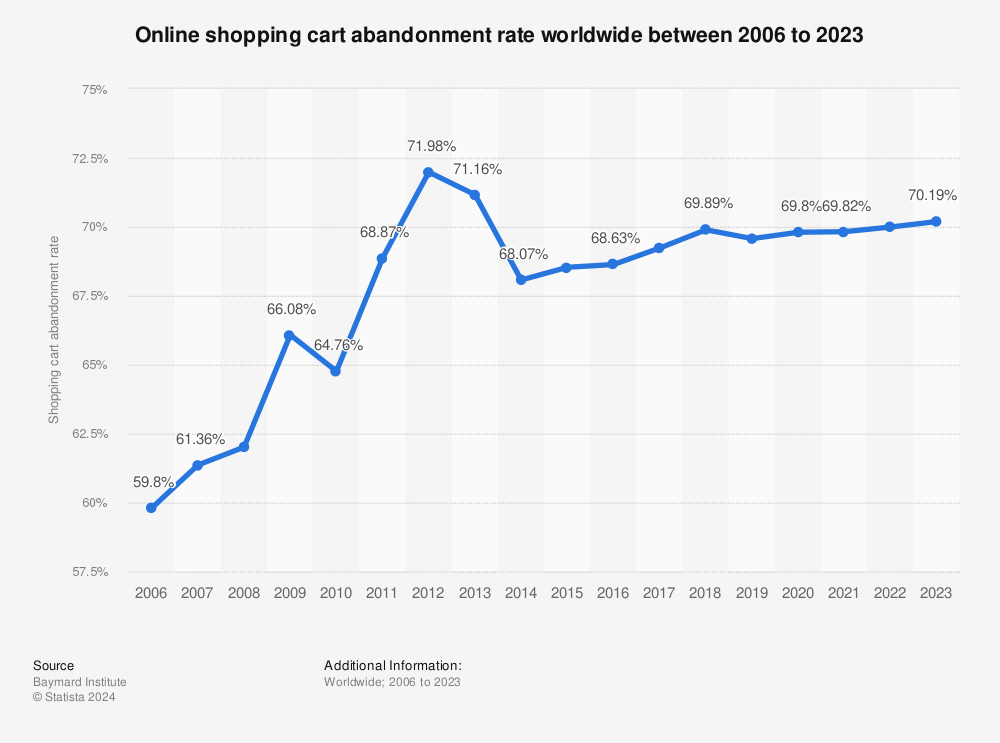Why Most Ecommerce Brands Struggle with Cart Abandonment (And How to Fix It)
Every ecommerce store has the same problem. People add things to their cart, then vanish.
It happens all the time. A shopper picks out a product, clicks "Add to Cart," and then, for whatever reason, they never complete the purchase. It’s frustrating. It’s costly. And it’s fixable.
If you're running an online store, you already know this pain. But here’s the good news: most brands recover almost nothing from abandoned carts. That’s your opportunity.
Let’s break this down. Why does cart abandonment happen? Why do most brands fail to recover lost sales? And what can you do today to fix it?
The Cold, Hard Truth About Abandoned Carts
Ecommerce brands lose billions every year to abandoned carts.
That’s not an exaggeration.

Here’s what the numbers say:
- The average cart abandonment rate is 70%.
- For every 10 shoppers who add something to their cart, 7 will leave without buying.
- The money lost? Over $18 billion in sales every year.
And yet, most brands do little about it. They send one generic email—if they send anything at all.
Here’s what they’re missing: People abandon carts for a reason. Fix the reason, and you recover the sale.
Why Do Shoppers Abandon Their Carts?
People don’t just leave for no reason.
They get stuck. They hesitate. Something makes them pause.

Here are the real reasons why:
1. Unexpected Costs (The Conversion Killer)
They reach checkout and see a surprise—taxes, shipping fees, handling charges.
Boom. Trust broken. Sale gone.
Fix it: Be upfront about costs. Offer free shipping thresholds to increase order value. Don’t let hidden fees kill your sale.
2. A Messy, Overcomplicated Checkout
Too many steps. Too many fields. Too much friction.
People hate hassle. If checkout feels like a chore, they quit.
Fix it: Streamline your checkout. Make guest checkout an option. Auto-fill customer details. Make it fast.
3. “Do I Really Need This?” (Buyer Hesitation)
People get second thoughts. They’re not sure. They think, "Maybe later."
Then later never comes.
Fix it: Build urgency. Show social proof. Remind them what they’re missing.
4. Payment Worries (Is This Safe?)
People don’t trust every store. If your checkout doesn’t look secure, they’ll walk away.
Fix it: Display trust badges, offer Shop Pay, PayPal, and Apple Pay. Make it obvious that checkout is safe and fast.
5. They Get Distracted (Real Life Happens)
They were ready to buy, but then their phone rang. A kid needed attention. Dinner was ready.
They didn’t mean to abandon the cart. They just forgot.
Fix it: Follow up. Send reminders. Bring them back.
Why Most Brands Fail to Recover Lost Sales
The big mistake? They assume an abandoned cart means a lost sale.
It doesn’t. It just means the customer didn’t buy yet.
Here’s where most brands go wrong:
❌ They Send Generic, One-Size-Fits-All Emails
A weak “Hey, you left something in your cart” email does nothing.
Your emails need to be timed right, well-written, and personalized.
❌ They Wait Too Long to Follow Up
By the time they send a reminder, the customer has moved on.
Speed matters. The first email should go out within 2-4 hours.
❌ They Don’t Use SMS
Some shoppers ignore emails. But they check their texts.
A simple SMS—"Hey, you left this in your cart. It’s still available!"—can recover the sale.
❌ They Ignore “Added to Cart” Shoppers
Many stores only target people who start checkout, but there’s another group:
- People who add to cart but never even reach checkout.
- These are high-intent shoppers, and most brands ignore them.
You can track these shoppers and send them a targeted follow-up.
How to Fix It: The Right Way to Recover Abandoned Carts
If you want to recover lost sales, you need an actual strategy.
Here’s what works:
✅ 1. Set Up a Multi-Step Abandoned Cart Flow
One email isn’t enough. You need a sequence:
- Email 1 (Sent after 2-4 hours): A simple reminder. Show the product. Add a clear CTA.
- Email 2 (Sent after 20-24 hours): Overcome objections. Add social proof (reviews, testimonials).
- Email 3 (Sent after 48 hours): If they still haven’t purchased, offer a small incentive (but don’t train them to expect discounts).
✅ 2. Track “Added to Cart” Events (Not Just Checkout)
To target all potential buyers, track both "Started Checkout" and "Added to Cart" events.
If someone adds to cart but doesn’t start checkout, follow up with a tailored message.
✅ 3. Add SMS to the Flow
Email is great, but SMS has a 98% open rate.
Use it. A well-timed text can bring people back. Example:
{{ person|lookup:"first_name"|default:'Hey There' }},
Your cart is waiting for you!
Don't miss out on the amazing products you left behind. Complete your order before it expires!
👉 Click to checkout now.
{{ event.extra.responsive_checkout_url }}
✅ 4. Fix the Checkout Experience
All the emails in the world won’t help if your checkout is painful.
- Remove unnecessary steps.
- Offer multiple payment options.
- Make checkout mobile-friendly.
Final Thoughts: Every Abandoned Cart Is a Second Chance
Shoppers leave. That’s normal.
But most brands never bring them back. That’s a mistake.
If you set up a proper abandoned cart flow, track “Added to Cart” events, and fix your checkout, you’ll recover thousands in lost sales—without spending a dime on extra traffic.
👉 In the next blog, we’ll show you exactly how to build a high-converting abandoned cart flow in Klaviyo. Stay tuned.